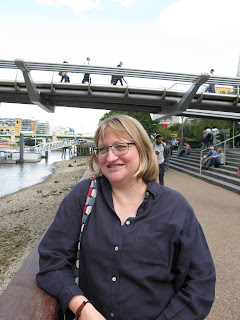To London, to see "Much Ado" at Shakespeare's Globe.
Homework:
I'm reasonably at home in central London, and can find my way around quite comfortably. Although we have been south of the river many times, to the Royal Festival Hall, Tate Modern, etc, we are not so familiar with the broader Bankside area, so this was an opportunity to explore a little more.
On arrival at St Pancras we made our way down to the southbound Thameslink platform and caught a train to Blackfriars station - a first for us.
To my genuine surprise we found that the station spans the width of the Thames, with entrances on both sides of the river. This composite photo shows the view downstream from the platform as we alighted:
This view never ceases to impress:
The extension to the Tate Modern, showing its proximity to the NEO Bankside apartment buildings - the reason for much controversy:
Below the ominous clouds can be seen the BT Tower peeking above Blackfriars station:
A somewhat more cheerful looking Amanda, with the Millennium Bridge behind her:
Immediately adjacent to the prison is the Clink Street branch of Gourmet Burger Kitchen, where we sought and found sustenance.
For your correspondent, a 6oz Classic Cheese (though here I appear to be eyeing someone else's meal):
Sated, we headed out to stretch our legs before making for The Globe. Almost immediately we came upon the St Mary Overie dock, where rests an exact replica of Sir Francis Drake's ship, The Golden Hind:
A poster for tonight's production:
Groundlings were starting to queue for access to the yard:
We had a quick cup of tea in the Foyer Café Bar, bought a programme, hired two seat cushions and made our way to our seats - the back row of the middle gallery, fairly central. This composite of three photos gives a good impression of the view:
The obligatory but unflattering selfie:
The programme:
As with Twelfth Night, this was a somewhat unconventional production, staging the action during the Mexican Revolution of 1915. And, as before, I enjoyed the show - but wasn't sure if the change of location, the modern-day additions to the text or the up-dating of some of the jokes added anything to the production. Also (feminists look away now) I'm not really sure what to make of Emma Rice's decision to aim for a 50/50 gender balance for roles in each play put on at The Globe. Does changing "Don John" to "Juanita", or "Antonio" to "Antonia" add anything artistically and, if not, can this 'affirmative action' be justified except as 'jobs for the girls'? Answers on a post card...
The Stage provides a useful summary of reviews from other publications, and for anyone wanting more details, these are all worth a look:
- British Theatre Guide
- Financial Times
- London's My Lobster
- Peter Viney's Blog
- The Guardian
- The Stage
- The Telegraph
- The Times
- What's On Stage
Out and retracing our steps back to Blackfriars. How can anybody fail to be moved by this view:
A smooth journey back to St Pancras, where we waited around an hour for the 00:15.
Here's Amanda, looking remarkably awake for 01.47:
And so, uneventfully, home and to bed at 02.40.































No comments:
Post a Comment